

Compact Muon Solenoid
LHC, CERN
| CMS-HIN-19-011 ; CERN-EP-2021-141 | ||
| Observation of $\mathrm{B^{0}_{s}}$ mesons and measurement of the $\mathrm{B^{0}_{s}}/\mathrm{B^{+}}$ yield ratio in PbPb collisions at ${\sqrt {\smash [b]{s_{_{\mathrm {NN}}}}}} = $ 5.02 TeV | ||
| CMS Collaboration | ||
| 4 September 2021 | ||
| Phys. Lett. B 829 (2022) 137062 | ||
| Abstract: The $\mathrm{B^{0}_{s}}$ and $\mathrm{B^{+}}$ production yields are measured in PbPb collisions at a center-of-mass energy per nucleon pair of 5.02 TeV. The data sample, collected with the CMS detector at the LHC, corresponds to an integrated luminosity of 1.7 nb$^{-1}$. The mesons are reconstructed in the exclusive decay channels ${\mathrm{B^{0}_{s}} \to \mathrm{J}/\psi\,\phi}$ and ${\mathrm{B^{+}} \to \mathrm{J}/\psi\,\mathrm{K^{+}}}$. The $\mathrm{B^{0}_{s}}$ meson is observed with a statistical significance in excess of five standard deviations for the first time in nucleus-nucleus collisions. The measurements are performed as functions of the transverse momentum of the B mesons and of the PbPb collision centrality. The ratio of production yields of $\mathrm{B^{0}_{s}}$ and $\mathrm{B^{+}}$ is measured and compared to theoretical models that include quark recombination effects. | ||
| Links: e-print arXiv:2109.01908 [hep-ex] (PDF) ; CDS record ; inSPIRE record ; HepData record ; CADI line (restricted) ; | ||
| Figures | |

png pdf |
Figure 1:
Invariant mass distributions of $\mathrm{B^{+}}$ (left) and $\mathrm{B^{0}_{s}}$ (right) candidates, for event centrality in the range 0-90%. The lower panels show the pulls, obtained as the difference between the data points and the fit result, divided by the uncertainty in data. |
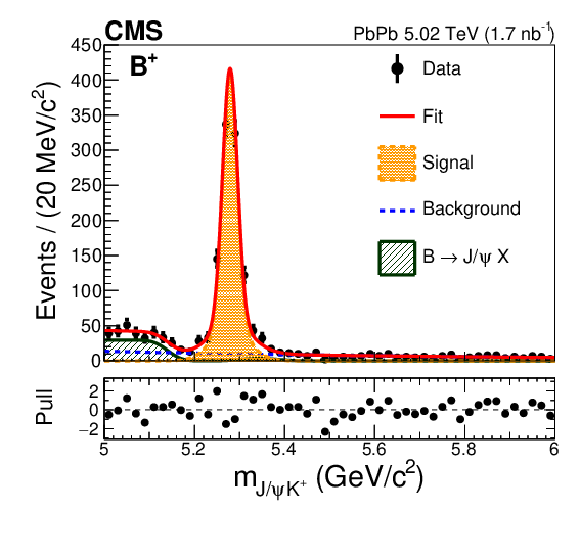
png pdf |
Figure 1-a:
Invariant mass distribution of $\mathrm{B^{+}}$ candidates, for event centrality in the range 0-90%. The lower panel shows the pulls, obtained as the difference between the data points and the fit result, divided by the uncertainty in data. |

png pdf |
Figure 1-b:
Invariant mass distribution of $\mathrm{B^{0}_{s}}$ candidates, for event centrality in the range 0-90%. The lower panel shows the pulls, obtained as the difference between the data points and the fit result, divided by the uncertainty in data. |
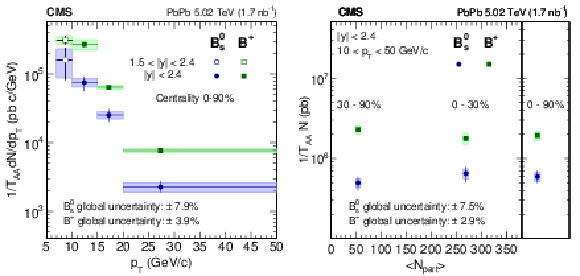
png pdf |
Figure 2:
The acceptance- and efficiency-corrected yields for the $\mathrm{B^{+}}$ and $\mathrm{B^{0}_{s}}$ mesons, scaled by ${T_{\mathrm {AA}}}$ and ${N_{\text {MB}}}$ in PbPb collisions at $ {\sqrt {\smash [b]{s_{_{\mathrm {NN}}}}}} = $ 5.02 TeV. The results are shown as a function of the meson ${p_{\mathrm {T}}}$ (left), and of the event centrality (right), where the rightmost panel indicates the centrality-integrated result. The vertical bars (boxes) correspond to statistical (systematic) uncertainties. The global systematic uncertainty comprises the uncertainties in ${T_{\mathrm {AA}}}$, ${N_{\text {MB}}}$, $\mathcal {B}$ (left) and $\mathcal {B}$ (right). |

png pdf |
Figure 2-a:
The ratio of $\mathrm{B^{0}_{s}}$ and $\mathrm{B^{+}}$ meson production yields, as a function of ${p_{\mathrm {T}}}$. The vertical bars (boxes) correspond to statistical (systematic) uncertainties. The global systematic uncertainty on the yields ratio corresponds to the decay branching fractions $\mathcal {B}$. Predictions from the TAMU transport model [23] and a Langevin hydrodynamics model [68] are overlaid. The yield ratio measured by LHCb in pp collisions at 7 TeV [69], scaled by the branching fraction ratio [57], is also displayed. |

png pdf |
Figure 2-b:
The ratio of $\mathrm{B^{0}_{s}}$ and $\mathrm{B^{+}}$ meson production yields, as a function of ${p_{\mathrm {T}}}$. collision centrality. The vertical bars (boxes) correspond to statistical (systematic) uncertainties. The global systematic uncertainty on the yields ratio corresponds to the decay branching fractions $\mathcal {B}$. Predictions from a Langevin hydrodynamics model [68] are overlaid. The yield ratio measured by LHCb in pp collisions at 7 TeV [69], scaled by the branching fraction ratio [57], is also displayed. |
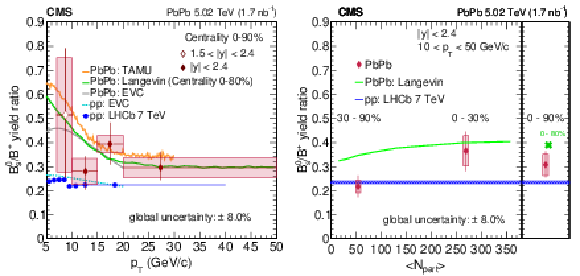
png pdf |
Figure 3:
The ratio of $\mathrm{B^{0}_{s}}$ and $\mathrm{B^{+}}$ meson production yields, as a function of ${p_{\mathrm {T}}}$ (left) and a function of collision centrality (right). The vertical bars (boxes) correspond to statistical (systematic) uncertainties. The global systematic uncertainty on the yields ratio corresponds to the decay branching fractions $\mathcal {B}$. Predictions from the TAMU transport model [23] (left panel only) and a Langevin hydrodynamics model [68] are overlaid. The yield ratio measured by LHCb in pp collisions at 7 TeV [69], scaled by the branching fraction ratio [57], is also displayed. |

png pdf |
Figure 3-a:
The ratio of $\mathrm{B^{0}_{s}}$ and $\mathrm{B^{+}}$ meson production yields, as a function of ${p_{\mathrm {T}}}$ (left) and a function of collision centrality (right). The vertical bars (boxes) correspond to statistical (systematic) uncertainties. The global systematic uncertainty on the yields ratio corresponds to the decay branching fractions $\mathcal {B}$. Predictions from the TAMU transport model [23] (left panel only) and a Langevin hydrodynamics model [68] are overlaid. The yield ratio measured by LHCb in pp collisions at 7 TeV [69], scaled by the branching fraction ratio [57], is also displayed. |
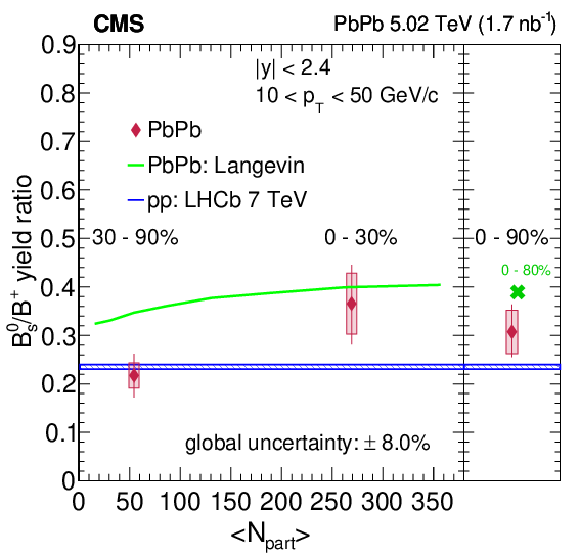
png pdf |
Figure 3-b:
The ratio of $\mathrm{B^{0}_{s}}$ and $\mathrm{B^{+}}$ meson production yields, as a function of ${p_{\mathrm {T}}}$ (left) and a function of collision centrality (right). The vertical bars (boxes) correspond to statistical (systematic) uncertainties. The global systematic uncertainty on the yields ratio corresponds to the decay branching fractions $\mathcal {B}$. Predictions from the TAMU transport model [23] (left panel only) and a Langevin hydrodynamics model [68] are overlaid. The yield ratio measured by LHCb in pp collisions at 7 TeV [69], scaled by the branching fraction ratio [57], is also displayed. |
| Tables | |

png pdf |
Table 1:
Summary of systematic uncertainties in the production yield measurements for $\mathrm{B^{+}}$ and $\mathrm{B^{0}_{s}}$ mesons, in three centrality ranges. The measurements are performed in the $\mathrm{B}$ meson kinematic region given by 10 $ < {p_{\mathrm {T}}} < $ 50 GeV/$c$ and $ {| y |} < $ 2.4. The relative uncertainty values are shown, in percentage. |
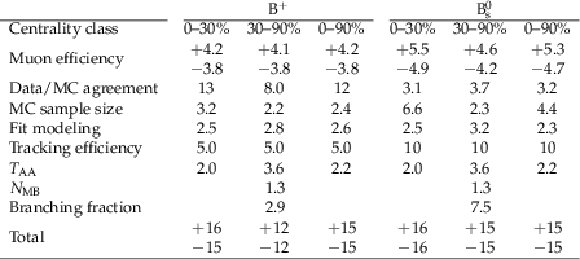
png pdf |
Table 2:
Summary of systematic uncertainties in the ${T_{\mathrm {AA}}} $-scaled yield measurements for $\mathrm{B^{+}}$ and $\mathrm{B^{0}_{s}}$ mesons, in three centrality ranges. The measurements are performed in the $\mathrm{B}$ meson kinematic region given by 10 $ < {p_{\mathrm {T}}} < $ 50 GeV/$c$ and $ {| y |} < $ 2.4. The relative uncertainty values are shown in percentage. |
| Summary |
| The $\mathrm{B^{0}_{s}}$ and $\mathrm{B^{+}}$ mesons are studied with the CMS detector at the LHC via the reconstruction of the exclusive hadronic decay channels ${\mathrm{B^{0}_{s}} \to \mathrm{J}/\psi\,\phi}$ and ${\mathrm{B^{+}} \to \mathrm{J}/\psi\,\mathrm{K^{+}}}$. The measurements are performed within the $\mathrm{B}$ mesons' fiducial region given by transverse momentum ${p_{\mathrm{T}}} > $ 10 GeV/$c$ for rapidity $ |y| < $ 1.5 and 7 $ < {p_{\mathrm{T}}} < $ 50 GeV/$c$ for 1.5 $ < |y| < $ 2.4. The first observation of the $\mathrm{B^{0}_{s}}$ meson in nucleus-nucleus collisions, with a statistical significance well surpassing five standard deviations, is attained. The production yields of $\mathrm{B^{0}_{s}}$ and $\mathrm{B^{+}}$ mesons, scaled by the nuclear overlap function ${T_{\mathrm{AA}}}$ and the number of minimum bias events ${N_{\text{MB}}}$, in lead-lead (PbPb) collisions at a center-of-mass energy of 5.02 TeV per nucleon pair are presented as functions of the meson ${p_{\mathrm{T}}}$ and, for the first time, of the event centrality. These results extend, and are compatible with, those previously reported by the CMS Collaboration [25,43], and are based on a three-fold larger PbPb data sample. The ratio of production yields of the two mesons in PbPb collisions is determined and it is found to be statistically compatible with the corresponding ratio in proton-proton (pp) collisions. The further investigation of possible hints of an enhancement of the ratio in PbPb, relative to pp collisions, will benefit from more precise PbPb and pp reference data taken at the same collision energy per nucleon. The larger PbPb data sets that should be accumulated in upcoming high-luminosity LHC heavy ion runs will provide greater precision and could help to further characterize the mechanisms of beauty hadronization in heavy ion collisions. |
| References | ||||
| 1 | J. C. Collins and M. J. Perry | Superdense matter: neutrons or asymptotically free quarks? | PRL 34 (1975) 1353 | |
| 2 | É. V. Shuryak | Theory of hadronic plasma | Sov. Phys. JETP 47 (1978)212 | |
| 3 | W. Busza, K. Rajagopal, and W. van der Schee | Heavy ion collisions: the big picture, and the big questions | Ann. Rev. Nucl. Part. Sci. 68 (2018) 339 | 1802.04801 |
| 4 | F. Karsch and E. Laermann | Thermodynamics and in-medium hadron properties from lattice QCD | in Quark-Gluon Plasma III, R. Hwa (ed.) 2003 | hep-lat/0305025 |
| 5 | A. Andronic et al. | Heavy-flavour and quarkonium production in the LHC era: from proton-proton to heavy-ion collisions | EPJC 76 (2016) 107 | 1506.03981 |
| 6 | X. Dong, Y.-J. Lee, and R. Rapp | Open heavy-flavor production in heavy-ion collisions | Ann. Rev. Nucl. Part. Sci. 69 (2019) 417 | 1903.07709 |
| 7 | J. D. Bjorken | Energy loss of energetic partons in quark-gluon plasma: possible extinction of high $ {p_{\mathrm{T}}} $ jets in hadron-hadron collisions | Fermilab PUB 82-059-THY | |
| 8 | R. Baier, D. Schiff, and B. G. Zakharov | Energy loss in perturbative QCD | Ann. Rev. Nucl. Part. Sci. 50 (2000) 37 | hep-ph/0002198 |
| 9 | CMS Collaboration | Observation and studies of jet quenching in PbPb collisions at $ {\sqrt {\smash [b]{s_{_{\mathrm {NN}}}}}} = $ 2.76 TeV | PRC 84 (2011) 024906 | CMS-HIN-10-004 1102.1957 |
| 10 | ATLAS Collaboration | Observation of a centrality-dependent dijet asymmetry in lead-lead collisions at $ {\sqrt {\smash [b]{s_{_{\mathrm {NN}}}}}} = $ 2.76 TeV with the ATLAS detector at the LHC | PRL 105 (2010) 252303 | 1011.6182 |
| 11 | A. Beraudo et al. | Extraction of heavy-flavor transport coefficients in QCD matter | NP A 979 (2018) 21 | 1803.03824 |
| 12 | ALICE Collaboration | $ {\mathrm{K^0_S}} $ and $ \Lambda $ production in PbPb collisions at $ {\sqrt {\smash [b]{s_{_{\mathrm {NN}}}}}} = $ 2.76 TeV | PRL 111 (2013) 222301 | 1307.5530 |
| 13 | STAR Collaboration | Strangeness enhancement in Cu+Cu and Au+Au collisions at $ {\sqrt {\smash [b]{s_{_{\mathrm {NN}}}}}} = $ 200 GeV | PRL 108 (2012) 072301 | 1107.2955 |
| 14 | STAR Collaboration | Energy and system size dependence of $ \phi $ meson production in Cu+Cu and Au+Au collisions | PLB 673 (2009) 183 | 0810.4979 |
| 15 | BRAHMS Collaboration | Kaon and pion production in central Au+Au collisions at $ {\sqrt {\smash [b]{s_{_{\mathrm {NN}}}}}} = $ 62.4 GeV | PLB 687 (2010) 36 | 0911.2586 |
| 16 | STAR Collaboration | Collision energy dependence of moments of net-kaon multiplicity distributions at RHIC | PLB 785 (2018) 551 | 1709.00773 |
| 17 | PHENIX Collaboration | $ \phi $ meson production in the forward/backward rapidity region in Cu+Au collisions at $ {\sqrt {\smash [b]{s_{_{\mathrm {NN}}}}}} = $ 200 GeV | PRC 93 (2016) 024904 | 1509.06337 |
| 18 | ALICE Collaboration | Enhanced production of multi-strange hadrons in high-multiplicity proton-proton collisions | NP 13 (2017) 535 | 1606.07424 |
| 19 | J. Rafelski and B. Muller | Strangeness production in the quark-gluon plasma | PRL 48 (1982) 1066 | |
| 20 | D. Molnar and S. A. Voloshin | Elliptic flow at large transverse momenta from quark coalescence | PRL 91 (2003) 092301 | nucl-th/0302014 |
| 21 | V. Greco, C. M. Ko, and P. Levai | Parton coalescence at RHIC | PRC 68 (2003) 034904 | nucl-th/0305024 |
| 22 | V. Greco, C. M. Ko, and R. Rapp | Quark coalescence for charmed mesons in ultrarelativistic heavy ion collisions | PLB 595 (2004) 202 | nucl-th/0312100 |
| 23 | M. He, R. J. Fries, and R. Rapp | Heavy flavor at the large hadron collider in a strong coupling approach | PLB 735 (2014) 445 | 1401.3817 |
| 24 | ALICE Collaboration | Measurement of $ {\mathrm{D^0}}$, ${\mathrm{D^+}}$, $\mathrm{D}^{*+} $ and $ \mathrm{D}^{*+}_{\mathrm{s}} $ production in PbPb collisions at $ {\sqrt {\smash [b]{s_{_{\mathrm {NN}}}}}} = $ 5.02 TeV | JHEP 10 (2018) 174 | 1804.09083 |
| 25 | CMS Collaboration | Measurement of $ \mathrm{B}^{0}_{\mathrm{s}} $ meson production in pp and PbPb collisions at $ {{\sqrt {\smash [b]{s_{_{\mathrm {NN}}}}}}} = $ 5.02 TeV | PLB 796 (2019) 168 | CMS-HIN-17-008 1810.03022 |
| 26 | CMS Collaboration | Measurement of the $ \mathrm{B^{+}} $ production cross section in $ pp\ $ collisions at $ \sqrt{s} = $ 7 TeV | PRL 106 (2011) 112001 | CMS-BPH-10-004 1101.0131 |
| 27 | CMS Collaboration | Measurement of the $ \mathrm{B}^{0}_{\mathrm{s}} $ production cross section in pp collisions at $ \sqrt{s} = $ 7 TeV | PRL 106 (2011) 252001 | CMS-BPH-10-005 1104.2892 |
| 28 | CMS Collaboration | Measurement of the $ \mathrm{B}^{0}_{\mathrm{s}} $ production cross section with $ \mathrm{B}^{0}_{\mathrm{s}} \to \mathrm{J}/\psi \phi $ decays in pp collisions at $ \sqrt{s} = $ 7 TeV | PRD 84 (2011) 052008 | CMS-BPH-10-013 1106.4048 |
| 29 | ATLAS Collaboration | Measurement of the differential cross-section of $ \mathrm{B^{+}} $ meson production in pp collisions at $ \sqrt{s} = $ 7 TeV at ATLAS | JHEP 10 (2013) 042 | 1307.0126 |
| 30 | LHCb Collaboration | Measurement of the $ \mathrm{B^{\pm}} $ production cross-section in pp collisions at $ \sqrt{s}= $ 7 TeV | JHEP 04 (2012) 093 | 1202.4812 |
| 31 | LHCb Collaboration | Measurement of B meson production cross-sections in proton-proton collisions at $ \sqrt{s} = $ 7 TeV | JHEP 08 (2013) 117 | 1306.3663 |
| 32 | LHCb Collaboration | Measurement of b-hadron production fractions in 7 TeV pp collisions | PRD 85 (2012) 032008 | 1111.2357 |
| 33 | LHCb Collaboration | Measurements of $ \mathrm{B}^{+}_{\mathrm{c}} $ production and mass with the $ {\mathrm{B}^{+}_{\mathrm{c}}} \to {\mathrm{J}/\psi} {\pi^{+}} $ decay | PRL 109 (2012) 232001 | 1209.5634 |
| 34 | CMS Collaboration | Measurement of the ratio of the production cross sections times branching fractions of $ \mathrm{B}^{\pm}_{\mathrm{b}} \to {\mathrm{J}/\psi} {\pi^{\pm}} $ and $ {\mathrm{B^{\pm}}} \to {\mathrm{J}/\psi} {\mathrm{K^{\pm}}} $ and $ \mathcal{B}(\mathrm{B}^{\pm}_{\mathrm{b}} \to {\mathrm{J}/\psi} {\pi^{\pm}}{\pi^{\pm}}{\pi}^{\mp})/\mathcal{B}(\mathrm{B}^{\pm}_{\mathrm{b}} \to {\mathrm{J}/\psi} {\pi^{\pm}}) $ in pp collisions at $ \sqrt{s} = $ 7 TeV | JHEP 01 (2015) 063 | CMS-BPH-12-011 1410.5729 |
| 35 | LHCb Collaboration | Study of the production of $ \Lambda^{0}_{\mathrm{b}} $ and $ {\mathrm{\overline{B}}^0} $ hadrons in pp collisions and first measurement of the $ {\Lambda^{0}_{\mathrm{b}}} \to {\mathrm{J}/\psi} {{\mathrm{p}}} {\mathrm{K^{-}}} $ branching fraction | CPC 40 (2016) 011001 | 1509.00292 |
| 36 | LHCb Collaboration | Measurement of $ \mathrm{B}^{+}_{\mathrm{c}} $ production in proton-proton collisions at $ \sqrt{s} = $ 8 TeV | PRL 114 (2015) 132001 | 1411.2943 |
| 37 | ATLAS Collaboration | Measurement of the relative $ \mathrm{B}^{\pm}_{\mathrm{b}}/{\mathrm{B}}^{\pm} $ production cross section with the ATLAS detector at $ \sqrt{s} = $ 8 TeV | PRD 104 (2021) 012010 | 1912.02672 |
| 38 | CMS Collaboration | Measurement of the total and differential inclusive $ \mathrm{B^{+}} $ hadron cross sections in pp collisions at $ \sqrt{s}= $ 13 TeV | PLB 771 (2017) 435 | CMS-BPH-15-004 1609.00873 |
| 39 | LHCb Collaboration | Measurement of the $ \mathrm{B^{\pm}} $ production cross-section in pp collisions at $ \sqrt{s} = $ 7 and 13 TeV | JHEP 12 (2017) 026 | 1710.04921 |
| 40 | LHCb Collaboration | Measurement of the $ \mathrm{B}^{-}_{\mathrm{c}} $ meson production fraction and asymmetry in 7 and 13 TeV pp collisions | PRD 100 (2019) 112006 | 1910.13404 |
| 41 | CMS Collaboration | Study of B meson production in pPb collisions at $ {\sqrt {\smash [b]{s_{_{\mathrm {NN}}}}}} = $ 5.02 TeV using exclusive hadronic decays | PRL 116 (2016) 032301 | CMS-HIN-14-004 1508.06678 |
| 42 | LHCb Collaboration | Measurement of $ \mathrm{B^{+}}$, $\mathrm{B}^{0}_{\mathrm{s}} $ and $ \Lambda^{0}_{\mathrm{b}} $ production in pPb collisions at $ {\sqrt {\smash [b]{s_{_{\mathrm {NN}}}}}} = $ 8.16 TeV | PRD 99 (2019) 052011 | 1902.05599 |
| 43 | CMS Collaboration | Measurement of the $ \mathrm{B^{\pm}} $ meson nuclear modification factor in PbPb collisions at $ {\sqrt {\smash [b]{s_{_{\mathrm {NN}}}}}} = $ 5.02 TeV | PRL 119 (2017) 152301 | CMS-HIN-16-011 1705.04727 |
| 44 | CMS Collaboration | Description and performance of track and primary-vertex reconstruction with the CMS tracker | JINST 9 (2014) P10009 | CMS-TRK-11-001 1405.6569 |
| 45 | CMS Collaboration | Dependence on pseudorapidity and centrality of charged hadron production in PbPb collisions at $ {\sqrt {\smash [b]{s_{_{\mathrm {NN}}}}}} = $ 2.76 TeV | JHEP 08 (2011) 141 | CMS-HIN-10-001 1107.4800 |
| 46 | CMS Collaboration | The CMS trigger system | JINST 12 (2017) P01020 | CMS-TRG-12-001 1609.02366 |
| 47 | CMS Collaboration | The CMS experiment at the CERN LHC | JINST 3 (2008) S08004 | CMS-00-001 |
| 48 | T. Sjostrand et al. | An introduction to PYTHIA 8.2 | CPC 191 (2015) 159 | 1410.3012 |
| 49 | CMS Collaboration | Event generator tunes obtained from underlying event and multiparton scattering measurements | EPJC 76 (2016) 155 | CMS-GEN-14-001 1512.00815 |
| 50 | J. Allison et al. | Recent developments in GEANT4 | NIMA 835 (2016) 186 | |
| 51 | D. J. Lange | The EVTGEN particle decay simulation package | NIMA 462 (2001) 152 | |
| 52 | E. Barberio, B. van Eijk, and Z. Was | PHOTOS: A universal Monte Carlo for QED radiative corrections in decays | CPC 66 (1991) 115 | |
| 53 | I. P. Lokhtin and A. M. Snigirev | A model of jet quenching in ultrarelativistic heavy ion collisions and high-$ {p_{\mathrm{T}}} $ hadron spectra at RHIC | EPJC 45 (2006) 211 | hep-ph/0506189 |
| 54 | CMS Collaboration | Charged-particle nuclear modification factors in PbPb and pPb collisions at $ {\sqrt {\smash [b]{s_{_{\mathrm {NN}}}}}} = $ 5.02 TeV | JHEP 04 (2017) 039 | CMS-HIN-15-015 1611.01664 |
| 55 | CMS Collaboration | Transverse momentum and pseudorapidity distributions of charged hadrons in pp collisions at $ \sqrt{s} = $ 0.9 and 2.76 TeV | JHEP 02 (2010) 041 | CMS-QCD-09-010 1002.0621 |
| 56 | CMS Collaboration | Performance of CMS muon reconstruction in pp collision events at $ \sqrt{s}= $ 7 TeV | JINST 7 (2012) P10002 | CMS-MUO-10-004 1206.4071 |
| 57 | Particle Data Group Collaboration | Review of particle physics | PRD 98 (2018) 030001 | |
| 58 | H. Voss, A. Hocker, J. Stelzer, and F. Tegenfeldt | TMVA -- the toolkit for multivariate data analysis | in XIth International Workshop on Advanced Computing and Analysis Techniques in Physics Research (ACAT), p. 40 2009 | physics/0703039 |
| 59 | M. Cacciari, M. Greco, and P. Nason | The $ {p_{\mathrm{T}}} $ spectrum in heavy-flavour hadroproduction | JHEP 05 (1998) 007 | hep-ph/9803400 |
| 60 | M. Cacciari and P. Nason | Charm cross sections for the Tevatron Run II | JHEP 09 (2003) 006 | hep-ph/0306212 |
| 61 | M. Cacciari et al. | Theoretical predictions for charm and bottom production at the LHC | JHEP 10 (2012) 137 | 1205.6344 |
| 62 | G. Cowan, K. Cranmer, E. Gross, and O. Vitells | Asymptotic formulae for likelihood-based tests of new physics | EPJC 71 (2011) 1554 | 1007.1727 |
| 63 | M. L. Miller, K. Reygers, S. J. Sanders, and P. Steinberg | Glauber modeling in high-energy nuclear collisions | Ann. Rev. Nucl. Part. Sci. 57 (2007) 205 | nucl-ex/0701025 |
| 64 | C. Loizides, J. Kamin, and D. d'Enterria | Improved Monte Carlo Glauber predictions at present and future nuclear colliders | PRC 97 (2018) 054910 | 1710.07098 |
| 65 | CMS Collaboration | Upsilon production cross-section in pp collisions at $ \sqrt{s} = $ 7 TeV | PRD 83 (2011) 112004 | CMS-BPH-10-003 1012.5545 |
| 66 | M. Pivk and F. R. Le Diberder | sPlot: a statistical tool to unfold data distributions | NIMA 555 (2005) 356 | physics/0402083 |
| 67 | B. Efron | Bootstrap methods: another look at the jackknife | Ann. Statist. 7 (1979) 1 | |
| 68 | S. Cao et al. | Charmed hadron chemistry in relativistic heavy-ion collisions | PLB 807 (2020) 133561 | 1911.00456 |
| 69 | J. Song, H.-h. Li, and F.-l. Shao | New feature of low $ {p_{\mathrm{T}}} $ charm quark hadronization in pp collisions at $ \sqrt{s} = $ 2.76 TeV | EPJC 78 (2018) 344 | 1801.09402 |
| 70 | LHCb Collaboration | Measurement of $ f_s / f_u $ variation with proton-proton collision energy and B-meson kinematics | PRL 124 (2020) 122002 | 1910.09934 |
| 71 | LHCb Collaboration | Precise measurement of the $ {f_s/f_d} $ ratio of fragmentation fractions and of $ \mathrm{B}^{0}_{\mathrm{s}} $ decay branching fractions | PRD 104 (2021) 032005 | 2103.06810 |
| 72 | HFLAV Collaboration | Averages of b-hadron, c-hadron, and $ \tau$-lepton properties as of 2018 | EPJC 81 (2021) 226 | 1909.12524 |
| 73 | LHCb Collaboration | Measurement of the fragmentation fraction ratio $ f_{s}/f_{d} $ and its dependence on B meson kinematics | JHEP 04 (2013) 001 | 1301.5286 |
| 74 | LHCb Collaboration | Measurement of b hadron fractions in 13 TeV pp collisions | PRD 100 (2019) 031102 | 1902.06794 |

|
Compact Muon Solenoid LHC, CERN |

|

|

|

|

|

|